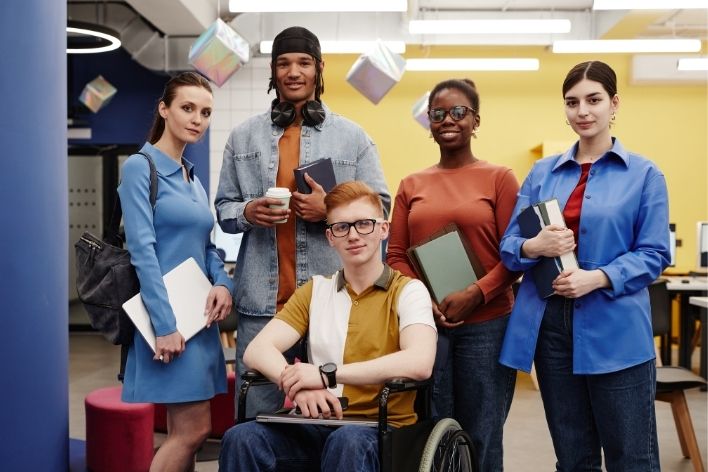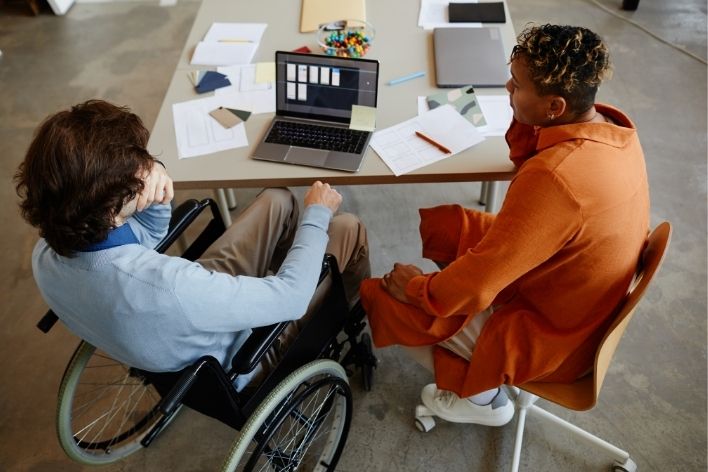What is Inclusive Education?
Samadrita Chakraborty |
Child Learning |
2024-08-12 |
null mins read

Table of Contents
- What is Inclusive Education?
- History of Inclusive Education in India
- Principles of Inclusive Education
- Why is Inclusive Education Important?
- Inclusive Education in India’s National Education Policy (NEP)
- Types of Inclusive Education
- Challenges to Inclusive Education
- Difference between Special Education and Inclusive Education
- Future of Inclusive Education
- Conclusion
- FAQS about Inclusive Education
Inclusive Education has become a critical aspect of modern educational systems around the world. It seeks to bridge the gap in order to offer equal opportunities to all learners, regardless of their differences, and assure that they are able to achieve their full potential. As we delve deeper into inclusivity in education, we'll explore its definition, principles, history, and the pivotal role it plays in fostering a fair and just educational landscape for all students.
What is Inclusive Education?
Inclusive Education is an approach to teaching students with diversified abilities and backgrounds under one classroom roof without any child losing an opportunity to learn and grow due to discrimination. This approach does not involve merely putting children with disabilities or special needs in regular schools; instead, it does this with active participation, respect, and equal learning opportunities for all children.
Inclusion is not a place, but it is a philosophy: embracing diversity and celebrating the strengths and efficiencies of all learners, while addressing individual needs. The concept makes sure that no child, either from the minority groups or having special needs, or coming from underprivileged backgrounds, gets left behind.
History of Inclusive Education in India

The historical background of inclusive education will be argued, starting from the civil rights movements in the 1950s and 1960s. Before that period, children with disabilities were often isolated in special schools or, even worse, denied education altogether. This struggle for equal rights in education was part of the wider global struggle to advocate for the civil rights of these marginalized groups in society.
Implementing IE (Inclusive education) took work too. In 2005, a survey found that 40 million children with different skills were deprived of mainstream education. Parents of regular children were strictly against them having education with their children. Stereotyped thoughts and ineffective authorities of many schools were significant obstacles for children with unique abilities.
Since 1880, India has established institutions for students with visual impairment or other disabilities. The scenario changed as the government implemented inclusive education with its correct meaning. In 1974, the National Council for Teacher Education centre was entrusted with a community to train teachers who can teach differently abled children. The community focused on children with mental disabilities as well as physical disabilities. According to the act 1995, the Central Board of Education made it compulsory for every school to facilitate a certain number of differently-abled children.
Globally, the United Nations Convention on the Rights of Persons with Disabilities (2006) underscored the importance of inclusive education as a human right. It mandated that all children, regardless of their abilities, should have access to quality education without discrimination. The adoption of Sustainable Development Goal 4 by the United Nations in 2015 further solidified the global commitment to inclusive, equitable, and quality education for all by 2030.
Principles of Inclusive Education
Success for any kind of inclusive education always begins with a deep understanding and the application of core principles that underpin its values. These guiding principles shall serve educators, policymakers, and institutions in creating environments that welcome diversity and provide equal opportunities for learners.
- Diversity is Celebrated
- Equal Access to Education
- Individualized Support
- Collaborative Learning
- Respect for All Learners
Why is Inclusive Education Important?

Inclusive education is a platform where students can create a culture of belonging and acceptance. We need a truly representative educational system that emulates the diversity found in society, wherein no student with disabilities or from minority groups lacks support.
Inclusive education fosters the development of empathy, understanding, and social responsibility among all students. When students of all different potentials and backgrounds learn together, they understand more about the world and the need for inclusion. It teaches children the ways of working together, respecting each other, and looking beyond differences.
Inclusive Education in India’s National Education Policy (NEP)
India's National Education Policy, 2020, has placed ample emphasis on inclusive education. The bold vision of the NEP is to transform the Indian education system into an equitable and inclusive one. To achieve equal access to education at all levels, special attention has been paid to children with disabilities under the policy.
Precisely, the NEP calls for the training of teachers in inclusive education principles and even calls for flexibility in school learning environments that would cater to various needs. It further calls for accessible infrastructure such as ramps and adapted learning materials for full inclusion of children with disabilities in the educational process.
Types of Inclusive Education
There are four types of inclusion according to the Rehabilitation Act of 1973. They are:
1) Individualised Education Program
Individual Education Programs must be designed for special education children in each public school. School officials, special and regular education teachers, and parents will be associated with modifying a learning plan. The learning plan must contribute to the goals and allow for future reevaluation and alterations.
2) Full-inclusion
Full inclusion goes for every student, regardless of learning disorder. Under this plan, all children will have a similar lesson plan. If the differently abled children face difficulties, a special education department teacher will follow up.
3) Partial Inclusion
Under partial inclusion, students with different abilities can interact with their peers in some classes. They can interact or play with other classmates in a standard classroom for some classes. In most of the child grooming classes, teachers from the special education department will take care of their lessons and speech therapies.
Challenges to Inclusive Education
While the ideals of inclusive education are very noble, putting them into practice is not without challenges. First, there is a general shortage of trained teachers ready to deal with diverse classrooms. Another challenge pertains to lacking resources, both in terms of specialized teaching aids and accessible learning environments.
Cultural attitude barriers may be formed towards children with disabilities or from minority groups. There are still communities in which certain disabilities carry a stigma that creates unease and embarrassment for children to go to school. Awareness and a culture of inclusion should continuously be raised, not only in schools but within the society in general.
Difference between Special Education and Inclusive Education
Special education is an entirely separate session for differently abled students. Specially equipped classrooms will strictly take care of the children with mental and physical disabilities. They will not be able to interact with physically and mentally sound children.
Inclusive education allows children to know their classmates with different abilities and boundaries. Inclusive education allows differently abled children to have education in a standard classroom with regular kids.
Future of Inclusive Education
The future for inclusive education appears to be bright, with increased attention by governments and other organizations to further its cause. New opportunities for education accessibility are also created through technology advancement. For example, assistive technology such as screen readers or text-to-speech software may facilitate the participation of students with disabilities in regular classrooms.
Indeed, to make it inclusive, further steps and collaboration among educators, families, governments, and communities are needed. This is how, together, we can ensure that all children-particularly the ones with all sorts of abilities-have equal opportunities to learn, grow, and achieve success.
Conclusion
Inclusive education is not only about teaching, but rather a commitment to allowing all the students from different backgrounds or with specific abilities to move forward. When we apply the principles of inclusivity in education, we can make the learning environment not only equitable for every student but also enriching.
From the historical background of inclusive education to its placement in modern policies like India's NEP, this is inclusivity's look toward the future of education around the world. This we do in the interest of creating a fairer and more decent world for the forthcoming generation.
FAQS about Inclusive Education
What are the 5 principles of inclusive education?
The five principles include celebrating diversity, equal access, personalized support, collaborative learning, and respect for all learners.
What is the aim of inclusive education?
The purpose of Inclusive Education is to assure equal quality education opportunities to all students without discrimination due to differences in abilities or background.
What is inclusive education in NEP?
In the Indian NEP, Inclusive Education implies equal opportunities for children with disabilities through declaration of access to infrastructure and qualified teachers.
Who is the father of inclusive education?
Dr. Wolf Wolfensberger: One of the important figures who can be attributed to this cause of inclusive education was due to his writings on the principle of normalization and the inclusion of people with disabilities.
Related Blogs:
Road Safety for Kids: Unlock essential road safety tips every child must know.
Animal and Their Babies: Unveil the hidden secrets behind animal baby care.
Science Experiments Benefits: Uncover the unexpected advantages of practical science learning
Percentage to CGPA Calculator: Learn how to convert the percentage to CGPA with our comprehensive step-by-step guide.
Importance of Online Education: Learn why online education is better through our latest blog.
Other Related Sections
NCERT Solutions | Learning Concepts I Sample Papers | CBSE SYLLABUS | Calculators | Converters | Stories For Kids | Poems for kids I Practice Worksheets I Formulas I Parent Resources

